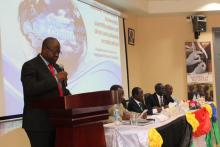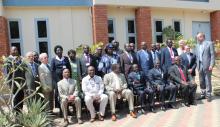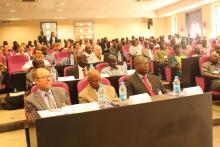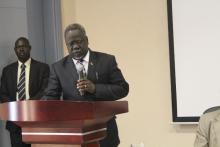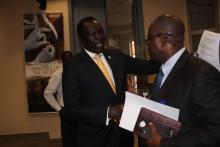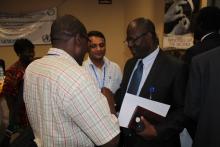South Sudan Inches Closer to Eliminating Guinea Worm Disease
“Imagine living with a snake-like worm about a metre long in your body?” It sounds unthinkable, but that is the painful reality that people affected by Guinea Worm Disease (GWD) have to live with. The question was posed by State Minister of Health for Western Equatoria, Dr. John Bona during the ninth annual review meeting of the Guinea Worm Programme in South Sudan, held under the theme: “Together for a final push to eliminate Guinea Worm Disease in South Sudan.”
South Sudan is one of the four remaining countries affected by the disease, together with Chad, Ethiopia and Mali.Dracunculiasis (commonly known as Guinea Worm Disease) is an infection with Dracunculus medinensis, a nematode worm, also known as Guinea worm. It is caused by drinking water containing water fleas (Cyclops species) that have ingested Dracunculus larvae. This worm is the largest of the tissue parasite affecting humans.
The Ministry of Health (MOH) in South Sudan, with support from partners, is involved in efforts to eliminate the disease by 2015 through multiple combined initiatives and has made major strides, successfully reducing cases over the last nine years since the establishment of the South Sudan Guinea Worm Elimination Programme (SSGWEP) in 2006. This year, 2015, is the targeted year to demonstrate interruption of transmission and partners are optimistic that this can be achieved given the progress made so far.
“WHO recognises the collective contribution of all stakeholders in the positive progress made in reducing the number of Guinea Worm Cases in South Sudan from 20,581 in 2006 to 70 in 2014,” says WHO Representative to South Sudan, Dr. Tarande Constant Manzila. He adds that this would not have been possible without the leadership of the Ministry of Health and financial and technical support from partners such as The Carter Center, UNICEF and WHO.
The 70 cases reported in South Sudan in 2014 constitute 56% of the 126 cases reported globally - making it the most affected country. Despite being the most affected of the four countries, experts say the rate of reduction in cases is phenomenal and above average compared to other countries that have achieved elimination. Unlike in the past, when cases were spread throughout the country, they are currently localised in Kapoeta East and Awerial counties in Eastern Equatoria and Lakes States.
Also worth celebrating is the reduction in the number of endemic villages from 3,134 in 2006 to 36 in 2014, says Minister of Health, Dr. Riek Gai Kok.
“There are only 36 remaining endemic villages in 2015, which raises hope for the possibility of eradicating the disease,” Dr. Kok says.
Progress made to date is attributed to collective interventions, distribution of customised filter pipes to the community for drinking water, a large community-based health structure of village volunteers at the village level, the case containment centres for isolating suspects and infected patients, treatment of water with Abate chemical and the introduction of the cash reward programme. The Guinea Worm Cash Reward Programme is an initiative through which people receive payment for reporting cases of Guinea Worm Disease. It is part of the surveillance mechanism that aims motivate people to report Guinea worm cases in support of efforts by the SSGWEP to eliminate the disease in South Sudan by 2015.
Despite the progress made, all partners concede that much more needs to be done in order to eradicate the disease. Sustainable access to potable drinking water, as well as sanitation and hygiene are essential to the fight against Guinea Worm Disease. However, according to Dr. Kok, only 42% of endemic villages have access safe drinking water.
Apart from providing safe drinking water to endemic villages, the Ministry of Electricity, Dams, Irrigation and Water Resources (MEDIWR) and its partners need to prioritize safe water provision to villages that are in close proximity to endemic clusters, which are also at-risk of importing cases. This also entails ensuring the availability of spare parts for repairing boreholes in affected counties and training local borehole repair teams, especially in areas that are far from town.
Further, there is need to market the cash reward programme country-wide.
“The key is in publicising the cash reward programme and ensure all cases are reported and treated. A single missed case can infect 80 or more people whose worms will only emerge the following year,” warns Vice President of Health Programs at The Carter Center, Dr. Donald Hopkins.
The recently ended review meeting, which took place on 21 and 22 January 2015, came up with a raft of recommendations to help speed up interruption of transmission of the disease.
The delegates recommended that the MOH should issue a nationwide proclamation announcing the cash reward programme and ensure of Government ministries receive it, as part of publicising the initiative.
Partnering with other community-based disease programmes to strengthen surveillance and public awareness, including the cash reward programme, would go a long way in eradicating the disease.
On its part, WHO has pledged to continue supporting the programme until the disease is eliminated in South Sudan.
“As we progress into 2015, WHO will continue to provide technical support to the MOH to ensure GWD surveillance is strengthened in all the 10 states; awareness on GWD and the cash reward programme is increased; cross border surveillance for GWD with the neighbouring countries of Ethiopia, Kenya and Sudan is strengthened; continued advocacy for more financial support to eliminate the last case of GWD. This will ultimately reduce the disease burden and prepare South Sudan for certification,” Dr. Manzila says.
__________________________________________________
1. WHO Representative to South Sudan, Dr. Tarande Constant Manzila, pledges WHO’s continued support in the fight against Guinea Worm Disease.
2. Some of the delegates who attended the Guinea Worm review meeting.
3. Some of the delegates who attended the review meeting to deliberate on eradicating Guinea Worm Disease.
4. The Minister of Health, Dr. Riek Gai Kok, is optimistic that South Sudan can meet the target of interrupting indigenous transmission of Guinea Worm Disease by the end of 2015.
5. Under Secretary in the Ministry of Health, Dr. Makur Matur Kariom, conferring with WHO Representative Dr. Tarande Constant Manzila.
6. WHO Representative Dr. Tarande Constant Manzila interacting with delegates at the review meeting.
Photo credits: WHO/M. Moyo

